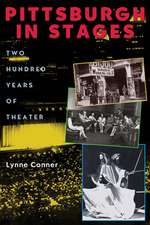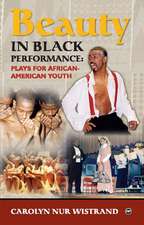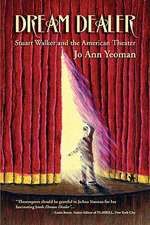American Scenic Design and Freelance Professionalism: Theater in the Americas
Autor David Bisahaen Limba Engleză Paperback – 28 noi 2022
An inclusive history of the professionalization of American scenic design
The figure of the American theatrical scenic designer first emerged in the early twentieth century. As productions moved away from standardized, painted scenery and toward individualized scenic design, the demand for talented new designers grew. Within decades, scenic designers reinvented themselves as professional artists. They ran their own studios, proudly displayed their names on Broadway playbills, and even appeared in magazine and television profiles.
American Scenic Design and Freelance Professionalism tells the history of the field through the figures, institutions, and movements that helped create and shape the profession. Taking a unique sociological approach, theatre scholar David Bisaha examines the work that designers performed outside of theatrical productions. He shows how figures such as Lee Simonson, Norman Bel Geddes, Jo Mielziner, and Donald Oenslager constructed a freelance, professional identity for scenic designers by working within their labor union (United Scenic Artists Local 829), generating self-promotional press, building university curricula, and volunteering in wartime service.
However, while new institutions provided autonomy and intellectual property rights for many, women, queer, and Black designers were not always welcome to join the organizations that protected freelance designers’ interests. Among others, Aline Bernstein, Emeline Roche, Perry Watkins, Peggy Clark, and James Reynolds were excluded from professional groups because of their identities. They nonetheless established themselves among the most successful designers of their time. Their stories expand the history of American scenic design by showing how professionalism won designers substantial benefits, yet also created legacies of exclusion with which American theatre is still reckoning.
The figure of the American theatrical scenic designer first emerged in the early twentieth century. As productions moved away from standardized, painted scenery and toward individualized scenic design, the demand for talented new designers grew. Within decades, scenic designers reinvented themselves as professional artists. They ran their own studios, proudly displayed their names on Broadway playbills, and even appeared in magazine and television profiles.
American Scenic Design and Freelance Professionalism tells the history of the field through the figures, institutions, and movements that helped create and shape the profession. Taking a unique sociological approach, theatre scholar David Bisaha examines the work that designers performed outside of theatrical productions. He shows how figures such as Lee Simonson, Norman Bel Geddes, Jo Mielziner, and Donald Oenslager constructed a freelance, professional identity for scenic designers by working within their labor union (United Scenic Artists Local 829), generating self-promotional press, building university curricula, and volunteering in wartime service.
However, while new institutions provided autonomy and intellectual property rights for many, women, queer, and Black designers were not always welcome to join the organizations that protected freelance designers’ interests. Among others, Aline Bernstein, Emeline Roche, Perry Watkins, Peggy Clark, and James Reynolds were excluded from professional groups because of their identities. They nonetheless established themselves among the most successful designers of their time. Their stories expand the history of American scenic design by showing how professionalism won designers substantial benefits, yet also created legacies of exclusion with which American theatre is still reckoning.
Preț: 407.87 lei
Nou
Puncte Express: 612
Preț estimativ în valută:
78.05€ • 83.46$ • 65.07£
78.05€ • 83.46$ • 65.07£
Carte disponibilă
Livrare economică 28 martie-11 aprilie
Livrare express 13-19 martie pentru 31.81 lei
Preluare comenzi: 021 569.72.76
Specificații
ISBN-13: 9780809338740
ISBN-10: 0809338742
Pagini: 270
Ilustrații: 27
Dimensiuni: 152 x 229 x 20 mm
Greutate: 0.43 kg
Editura: Southern Illinois University Press
Colecția Southern Illinois University Press
Seria Theater in the Americas
ISBN-10: 0809338742
Pagini: 270
Ilustrații: 27
Dimensiuni: 152 x 229 x 20 mm
Greutate: 0.43 kg
Editura: Southern Illinois University Press
Colecția Southern Illinois University Press
Seria Theater in the Americas
Notă biografică
David Bisaha is an assistant professor of theatre history at Binghamton University, State University of New York. His scholarship has been published in Theatre & Performance Design, Theatre Survey, Theatre Journal, Theatre History Studies, and in the edited collections The Routledge Companion to Scenography and Theatre and the Macabre.
Extras
PREFACE
Scholars of US-American theatre history have pointed to examples of racist ideology portrayed onstage and have critiqued them diligently. When discussing canonical artists, stories, and conventions, theatre and performance scholarship must acknowledge that it is upholding Anglo-Eurocentrism and that doing so contributes to the continued dominance of white voices in the American theatre. At the same time, it is important to acknowledge the ways in which the economic and educational systems of American theatre have enacted racist and sexist policy, and still do. In many cases discrimination hides behind rhetoric of quality, technique, relatability, or standards. These, too, are beginning to receive scholarly attention, but not nearly as much.
American Scenic Design and Freelance Professionalism tells the story of the emergence of a new field, but also explains its exclusionary and discriminatory effects. This book emphasizes the effects of racism, sexism, and homophobia by giving excluded designers necessary attention in their own sections. In many cases, precisely due to discrimination, the archive is much smaller for excluded designers. Their lives took differing paths, which this book conceptualizes as counterpoints to the predominantly white, male, and elite story of scenic design professionalization. This counterpoint approach acknowledges that the actions of Aline Bernstein, Emeline Roche, Perry Watkins, and James Reynolds did not create the system within which they worked. They did not have the power to decide the terms of professionalization when it was being organized by their straight white male colleagues. Their actions were in response to a system that was not built for them, one that was hostile to their work and aspects of their humanity. This book details how such systems of status and exclusion were built, yet it also attends to counterpointing examples to show that exclusionary systems can be broken into, broken down, and broken apart.
In order to change, American theatre must acknowledge that the banner of professionalization has been raised to protect the well-off and to justify exclusion. Examples throughout this book show that the creation of a new labor category benefits those who establish it, but it also empowers them to set the terms of professional membership. Solving the problems of exclusion means looking closely at exactly what professionals gain by claiming that term, and what educational institutions gain by teaching students “professional” standards. It requires questioning the “givens” of the field to make the field more equitable. Its terms of entry – union dues, apprenticeships, expensive education, a commitment to self-promotion and service – are exclusionary, and some must be completely reformed.
[end of excerpt]
Scholars of US-American theatre history have pointed to examples of racist ideology portrayed onstage and have critiqued them diligently. When discussing canonical artists, stories, and conventions, theatre and performance scholarship must acknowledge that it is upholding Anglo-Eurocentrism and that doing so contributes to the continued dominance of white voices in the American theatre. At the same time, it is important to acknowledge the ways in which the economic and educational systems of American theatre have enacted racist and sexist policy, and still do. In many cases discrimination hides behind rhetoric of quality, technique, relatability, or standards. These, too, are beginning to receive scholarly attention, but not nearly as much.
American Scenic Design and Freelance Professionalism tells the story of the emergence of a new field, but also explains its exclusionary and discriminatory effects. This book emphasizes the effects of racism, sexism, and homophobia by giving excluded designers necessary attention in their own sections. In many cases, precisely due to discrimination, the archive is much smaller for excluded designers. Their lives took differing paths, which this book conceptualizes as counterpoints to the predominantly white, male, and elite story of scenic design professionalization. This counterpoint approach acknowledges that the actions of Aline Bernstein, Emeline Roche, Perry Watkins, and James Reynolds did not create the system within which they worked. They did not have the power to decide the terms of professionalization when it was being organized by their straight white male colleagues. Their actions were in response to a system that was not built for them, one that was hostile to their work and aspects of their humanity. This book details how such systems of status and exclusion were built, yet it also attends to counterpointing examples to show that exclusionary systems can be broken into, broken down, and broken apart.
In order to change, American theatre must acknowledge that the banner of professionalization has been raised to protect the well-off and to justify exclusion. Examples throughout this book show that the creation of a new labor category benefits those who establish it, but it also empowers them to set the terms of professional membership. Solving the problems of exclusion means looking closely at exactly what professionals gain by claiming that term, and what educational institutions gain by teaching students “professional” standards. It requires questioning the “givens” of the field to make the field more equitable. Its terms of entry – union dues, apprenticeships, expensive education, a commitment to self-promotion and service – are exclusionary, and some must be completely reformed.
[end of excerpt]
Cuprins
CONTENTS
List of Figures
Preface
Acknowledgments
Introduction: Design Labor and Freelance Professionalism
1. The Unionized Artist: Organizing the Profession
2. The Celebrity Artist: Promoting the Designer
3. The Teaching Artist: Building University Curricula
4. The Consulting Artist: Serving the Needs of Others
Conclusion: Legacies of Professionalism
Notes
Bibliography
Index
List of Figures
Preface
Acknowledgments
Introduction: Design Labor and Freelance Professionalism
1. The Unionized Artist: Organizing the Profession
2. The Celebrity Artist: Promoting the Designer
3. The Teaching Artist: Building University Curricula
4. The Consulting Artist: Serving the Needs of Others
Conclusion: Legacies of Professionalism
Notes
Bibliography
Index
Recenzii
“This is a unique and much-needed study of the emergence of the designer as an artistic force in American theatre practice in the early 20th century, and it traces the complex evolution of a theatre designers’ union. David Bisaha also explores how this same union often turned a blind eye to the struggles of women and people of color in the field. This essential book sheds light on a crucial but frequently overlooked aspect of American theatre history."—Arnold Aronson, author of Ming Cho Lee: A Life in Design
“Bisaha offers a fascinating perspective on a unique period in American theatre. He provides a highly detailed presentation of intersectional information, bringing many overlooked contributions to light.”—Wendy Rae Waszut-Barrett, coeditor of The Santa Fe Scottish Rite Temple: Freemasonry, Architecture, and Theatre
“Bisaha offers a fascinating perspective on a unique period in American theatre. He provides a highly detailed presentation of intersectional information, bringing many overlooked contributions to light.”—Wendy Rae Waszut-Barrett, coeditor of The Santa Fe Scottish Rite Temple: Freemasonry, Architecture, and Theatre
























